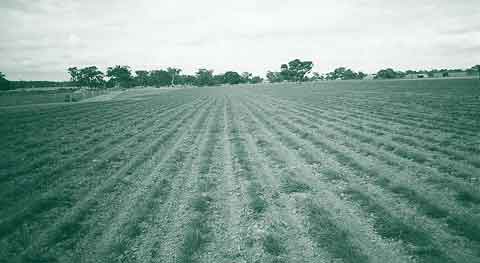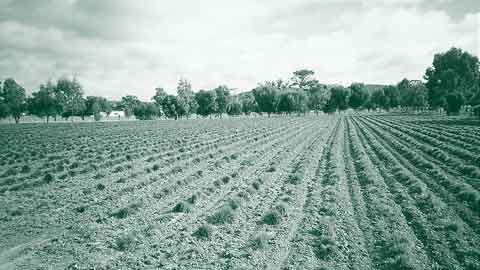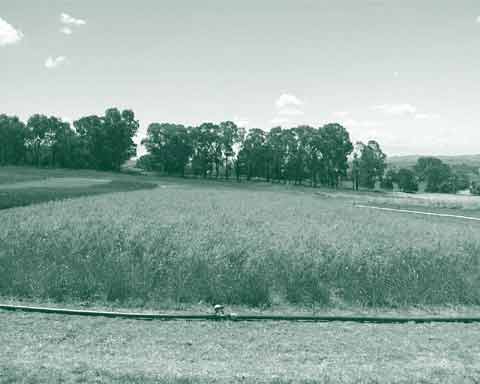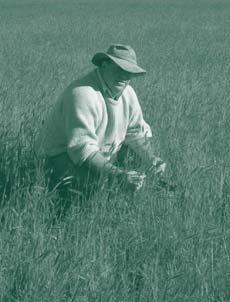
Grassed up - General guidelines for seed production
Sown stands
A major limitation to the further use of native grasses is fickle availability and high cost of seed. Individuals interested in producing and/or supplying seed to meet these markets have two options. Seed production areas can be sown and managed as a traditional seed crop or wildland stands can be managed to produce seed.
Using sown stands of irrigated grasses with adequate weed management will lead to higher seed yields, higher seed purity and better germination of the resultant seed samples compared with harvesting wild stands. On the other hand, the technology for producing seed from sown stands, and their management is only just being explored. For many species, harvesting seed from wild stands is the only option for seed production. Guidelines for the harvesting and sowing of a number of grasses are in the Species quick reference.
6.1 Sown stands
Sowing a stand of native grass for the purpose of seed production has many advantages over harvesting seed from the wild. Crop management can ensure that the seed product can be physically pure from weed contamination as well as genetically pure (known variety or local ecotype). In comparison to wild stands, sown stands will have more uniform plant density and as a consequence higher seed yields (Picture 24 and Picture 25).
Picture 24 (below). Hume Wallaby grass (Austrodanthonia richardsonii) seed production at Native Seeds, Toolern Vale, Victoria. (Photograph I. Chivers)

Species selection
Species selected for sowing must be adapted to the soils and climatic conditions of the planting site (Species quick reference). Considerable investment is often expended to establish seed production areas, and maximum production for several years is required to recoup this investment. Past experience shows that investment recovery rate depends on yields and the seed price. In addition, species selected for sowing should have a reasonable market potential. The sale of some native seed may currently be limited by high production costs or market fluctuations, yet may still be profitable if appropriate marketing is employed.
The decision to sow a cultivar (broadly adapted type) or local ecotype (locally adapted type) for seed production should be carefully considered. Summary Table iii lists current varieties registered under Plant Breeders Rights legislation as well as some other varieties under development. Individuals considering producing seed of registered varieties should note that exclusive seed production arrangements usually apply and are legally enforceable.
Picture 25 (below). Wakefield weeping grass (Microlaena stipodies) as one year old plants at Native Seeds, Toolern Vale, Victoria. (Photograph I. Chivers)

Species selected for growing should be compatible with existing operations. Some species require more time to reach full production, or may require special attention and equipment to produce and process. Establishment and rearing costs, including equipment costs, can be substantial and growers must select species that meet their economic constraints. Producing native grass seed that has a broad range or area of adaptation will ensure the greatest market potential. In the absence of herbicide recommendations manual labour will be required to establish new plantings and maintain field purity. Growers should be certain this resource is available. Since the source seed of local ecotypes is likely to come from wild stands, care must be taken to avoid weed contamination.
Site selection
Sites selected for seed production need to be carefully matched with the species to be sown. Not all sites suitable for cropping are suitable for seed production. Areas subjected to damaging frosts, extensive winds and unusually hot conditions should be avoided. Whilst native species may tolerate poorer soils, seed production potential may be limited on these sites. Species with their major growth periods in the warm or cool season should be matched to their natural climatic zone or conditions (see Species quick reference).
Ideal soils are those that are friable and can be tilled without crusting or becoming impervious to water.
Seed bed preparation and weed control
It is essential that weeds are controlled before sowing native grasses for seed production. Paddocks should be free of noxious and troublesome weeds prior to sowing. Weed competition, especially from annual weeds is a major cause of establishment failures with slow establishing native grasses. One or two seasons of carefully scheduled tillage and use of herbicides may be required to eliminate weeds. The use of a competitive crop on the site for one or two years may also assist in weed control. Small grains and other agricultural crops should not be allowed to set seed and contaminate seed production areas.
Picture 26 (below). Breeders seed increase of Austrodanthonia fulva (LIG-179) on Centre for Natural Resources, Research Centre, Cowra NSW. (Photograph I. Cole)

The site should be properly prepared to create a firm and uniform seed bed. Failure to provide a firm seed bed often results in non-uniform emergence and uneven stands that will reduce seed production potential and encourage weed invasion. One of the best ways to ensure an ideal seedbed is to precede the seeding year by a season or partial season of summer fallow. Fallowing not only provides a firmly packed, finely granulated seedbed, it also allows full recharge of the soil moisture profile, enhances nutrient availability, allows rapid soil warming in the spring and reduces weed problems. Summer fallowing is not recommended on light soils that are prone to wind erosion or on steep slopes subject to water erosion.
Row spacings
Sowing in rows offers advantages compared with broadcast stands. Inter-row cultivation and the use of hooded spraying equipment for weed control is then possible and there is increasing evidence that high seed yields can be maintained for more years from row seed crops than from swards (Picture 26). The latter tend to become sod-bound and unthrifty after a few years with markedly reduced seed yields. The row spacings often depend on available equipment and little information is available about the ideal spacings for different species. However, the larger the individual mature plants, the wider the row spacing should be. In general terms, 500 to 800 mm has proved to be satisfactory. Species information sheets in Section 8 provide further details where they are known.
Plant spacings within the rows should be such that the plants form a continuous row as soon as possible to provide competition for weed seedlings within the rows. The slow seedling growth rates of many native perennial grasses mean that row closure is usually slower than is the case with the traditional grass seed crops hence the importance of weed management mentioned above. Plant densities within the rows of 5 to 10 seedlings per linear metre depending on the size of the mature plants are satisfactory for most native grasses.
Management
Information about the best management of irrigated stands for maximum seed production and maximum life of the stand is simply not known for native grasses. Many of them have indeterminate flowering (see section 2.1) making it possible to harvest more than one crop per year. Usually there is a need to fertilise and water after each crop is harvested to stimulate a second flush of seeds. However, it should be noted that the highest yields are usually from the first 'flush' of seed. For species that have determinate flowering, the timing of fertiliser application and irrigation could be critical. The requirements for individual species need to be worked out by a process of trial and error. Available information is included in the individual species sheets in Section 8.
The removal of trash following the final harvest for each growing season is essential for high yields in the subsequent season. Grazing, slashing and raking, or burning are all methods that have been used for grasses in established seed industries but little information is available on the best methods for most native grasses. There are potential advantages in the use of fire because, if it is used properly, it can reduce the weed seed population for the next year by destroying weed seeds present on the soil surface and also reduce fungal disease inoculum if such diseases are a problem.
Fire should only be used under the following conditions:
- There is sufficient fuel of low enough water content to carry a fire of sufficient intensity to destroy weed seeds and fungal inoculum. On the other hand, if there is too much fuel and it is too dry, the fire may be difficult to control. Expert advice and the approval of local fire authorities must always be obtained before burning.
- The soil must be moist or some mortality of plants can occur.
- The stand should not be grazed or mown between burning and the maturation of the next seed crop.
- Fertiliser applications could be necessary, depending on the species, soon after burning and just prior to the commencement of regrowth.
If conditions are not exactly right for the use of fire, it is better not to burn and to use other methods of trash removal.
Wild stands

Harvesting seed from wild stands is effective for supplying local provenance seed, however seed yields are driven by local seasonal conditions and seed lots are often contaminated with both annual and perennial weed species (Picture 27).
Picture 27 (right). A wild stand of Dichanthium sericeum ready for harvest at Trangie, central western New South Wales. (Photograph C. Waters)
The management of wild stands of grasses for maximum and sustained seed production is a developing science. What little information is available is included in the notes for individual species in Section 8. In general terms, the stand should be managed during the non-growing season of the target species to decrease the abundance of the weed species (or the non-target pasture species). The techniques available for this process include the use of selective herbicides, targeted high animal density grazing and occasional scarification or renovation. With some species, the judicious use of fire can increase stand density and seed production. The same principles apply to the use of fire in wild stands as for sown stands.
The judicious use of fertilisers and irrigation can also increase seed production and the life of the stand for some species. Again, the characteristics and behaviour of the individual species must be understood, and available information is included in Section 8.

